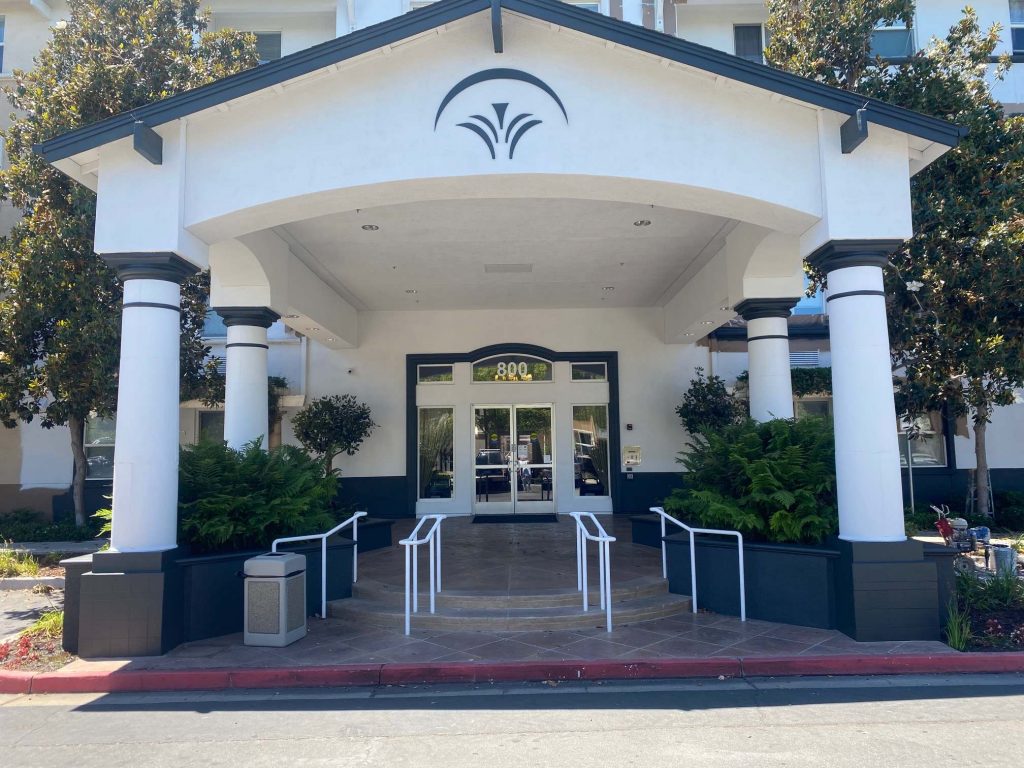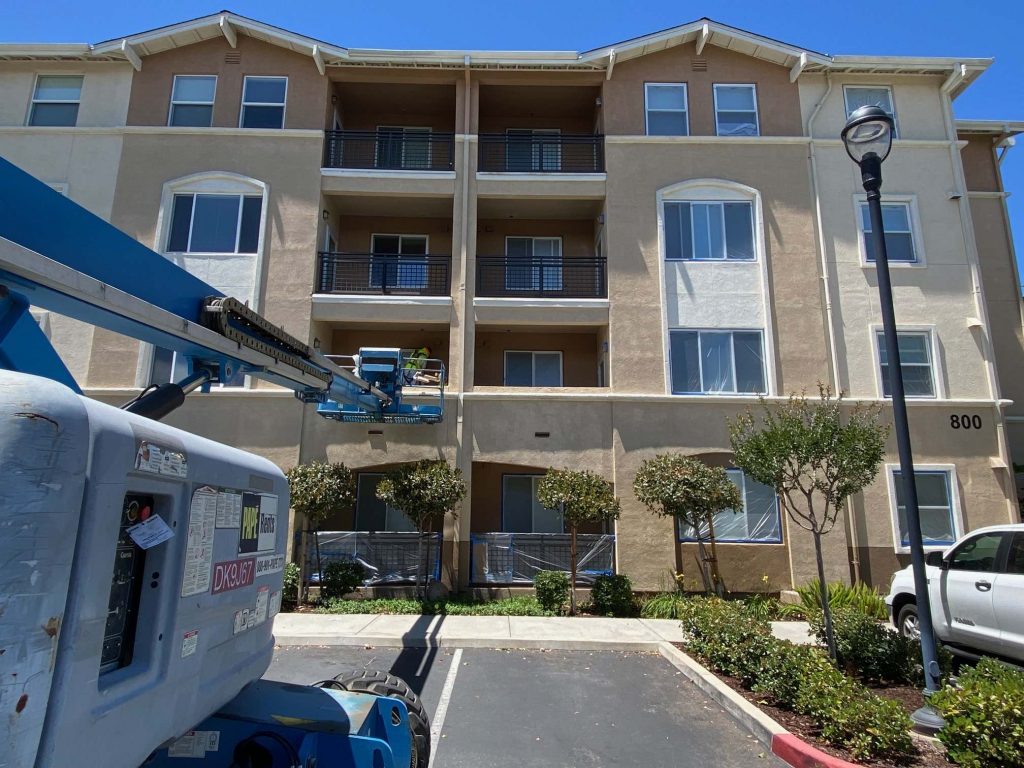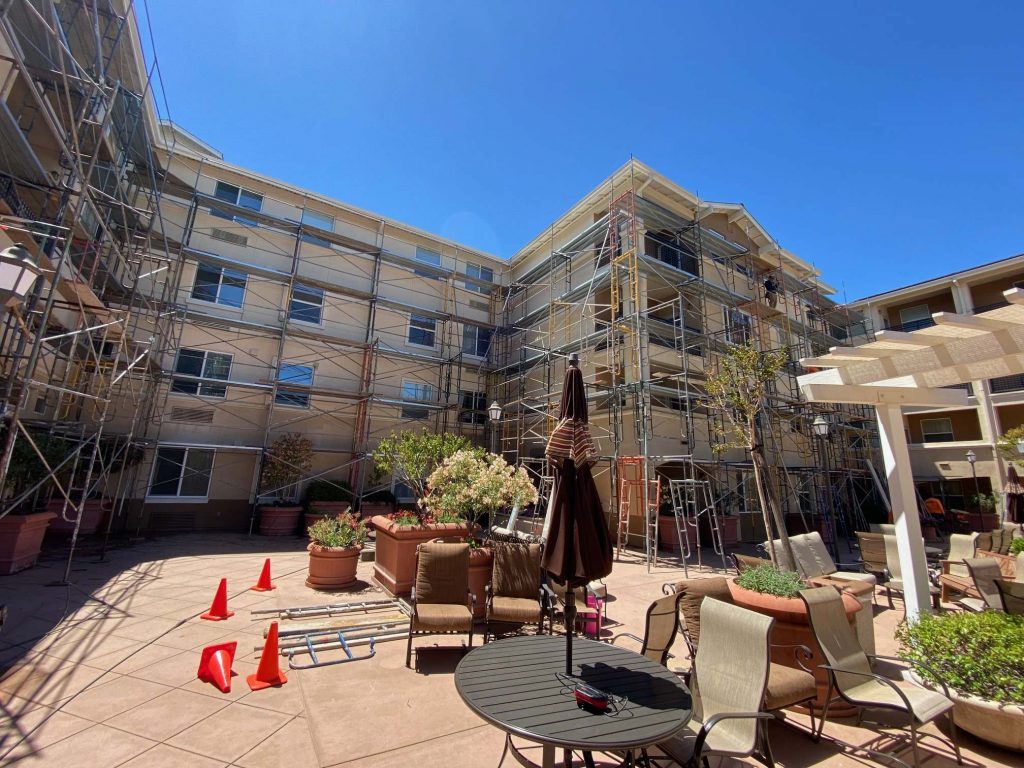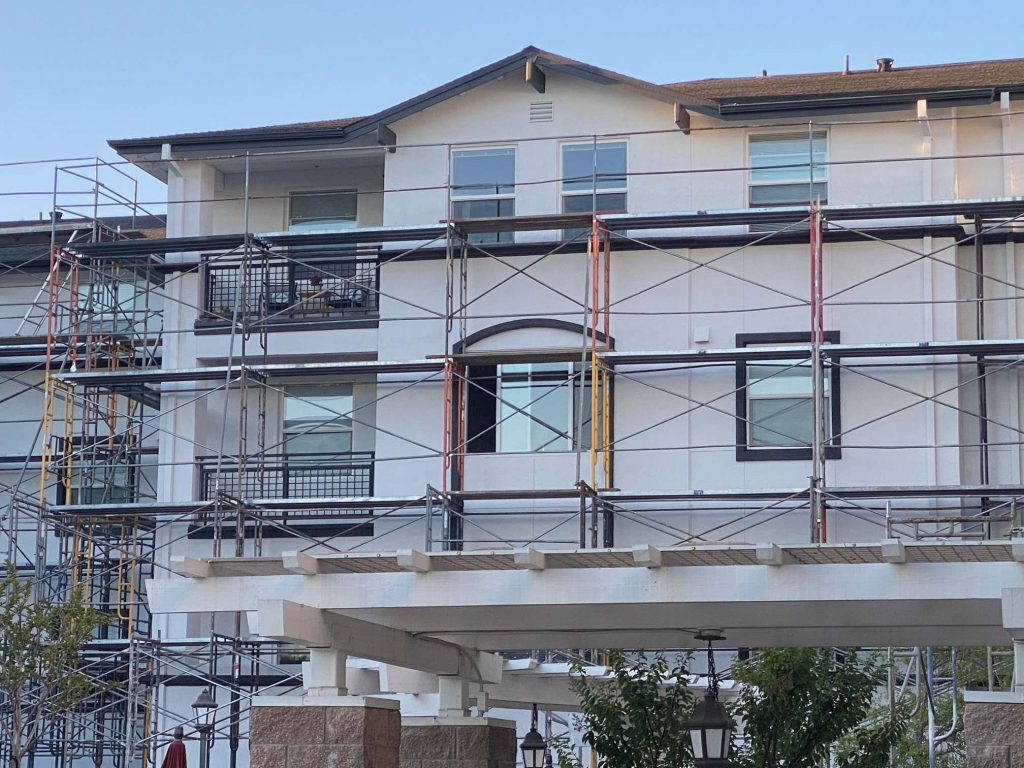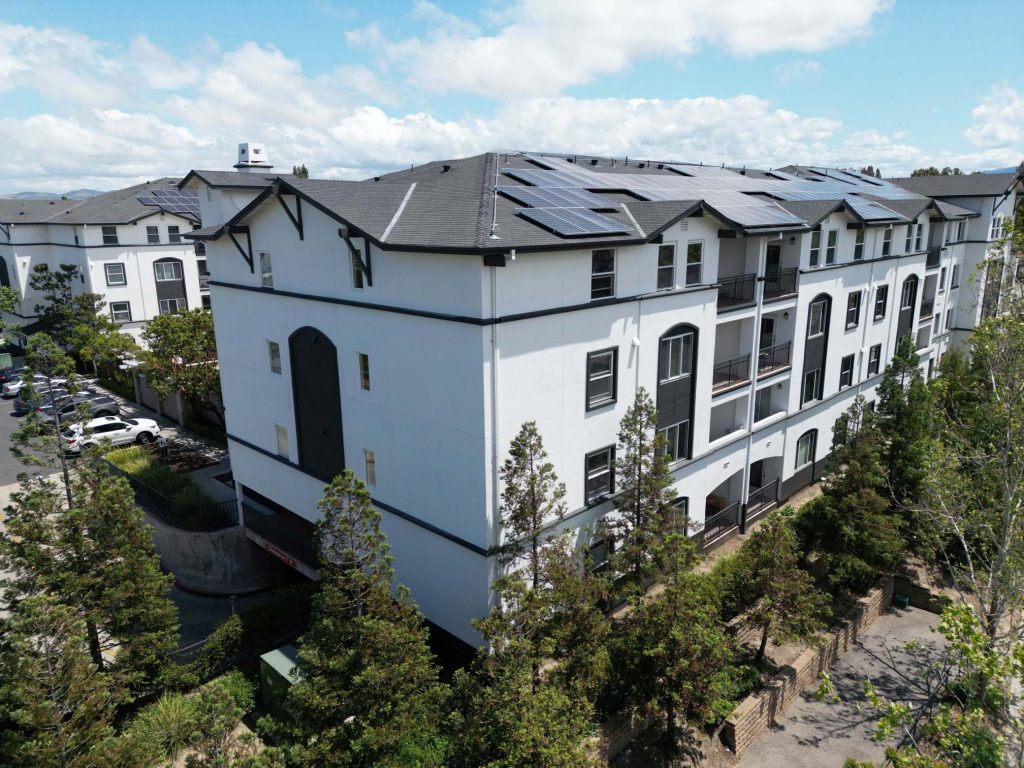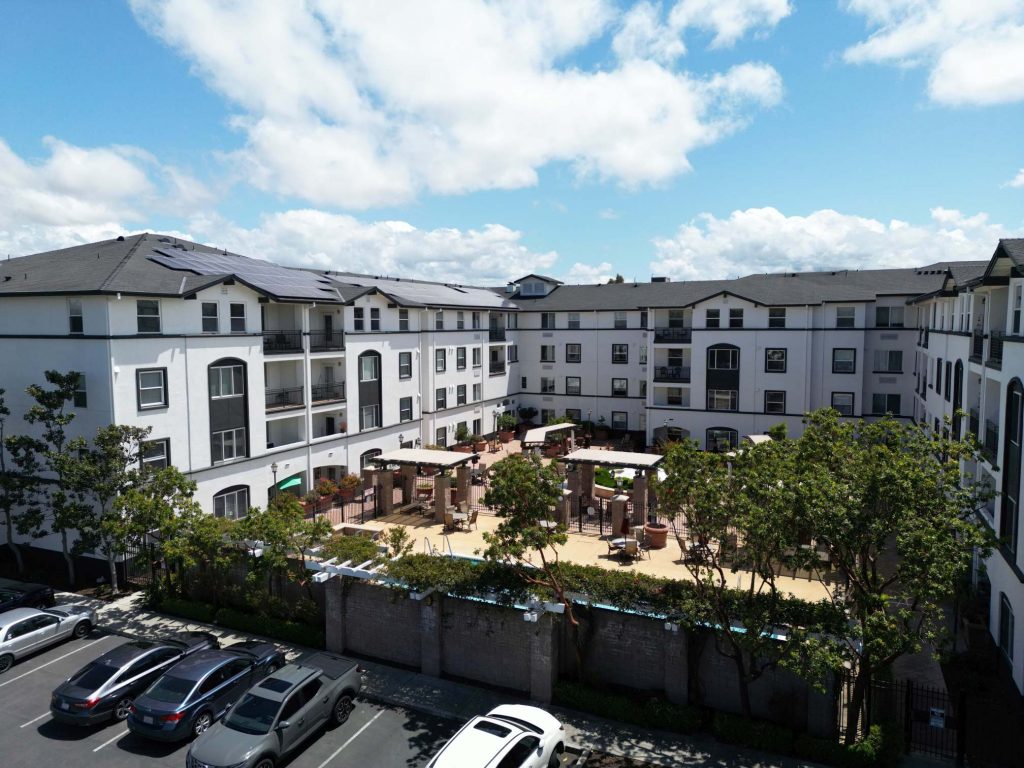Whenever a painting company like Custom Painting, Inc. does exterior painting on a multi-tenant building, there are challenges to overcome. Depending upon the size of the building being painted and how many stories it has, it is vital to keep tenants, employees, and foot traffic safe. There are many ways to maintain safety, and we’ll explain them in the following article.
Building Size
Heritage Estates is a multi-tenant senior living facility located in Livermore. According to Klein Financial Corporation’s website, the complex is situated on 8.38 acres and comprises 60 to 65 assisted living and 190 independent living units. It has a gross building area of approximately 244,000 square feet.
We were recently contracted to paint their multi-building complex in two phases. The first phase, which we have completed, was for the senior apartment building. The second phase, which should commence in the spring/summer of 2023, is their assisted living building.
Exterior Features
When viewed from the top, the senior apartment building looks like a square with one side missing. There are approximately 20 patios and balconies in the complex.
The building has four stories, each measuring 9 to 11 feet high. However, in some areas, stories may be as high as 13 feet. Before the paint project began, the building featured all-white walls with dark paint on the roofing, trim, railings, and fascia. The railings for the balconies are made of metal.
Phase One of the Project
Phase one consisted of painting the exterior of a four-story stucco building, with some residences having private patios and balconies. The request was to repaint the structure’s exterior with a new and updated color scheme. It took us around four weeks to complete phase one.
Challenges and Concerns
There were many challenges and concerns to this project.
1) One of our primary concerns is always safety for our employees and the tenants and employees of an occupied space. With more than 100 tenants living in the building with lives both inside and outside, we had to take great care that they would be safe while leaving and returning home.
2) The height of the building meant we would have to work from aerial boom lifts to reach the higher portions of the building. The structure sits on top of an underground parking garage, which meant we could not use lifts to access the center courtyard (half of the building) due to structural weight restrictions. The building also sits on the corner of two busy streets and is bordered on two sides by sidewalks with regular foot traffic.
Overcoming the Challenges
To keep the residents safe, we would close off one door at a time in the area where we were performing work. We also provided alternative access options.
In the courtyard, where we could not use the lifts, we had to erect scaffolding around the entire area. Erecting scaffolds allowed us full access to the exterior walls without exceeding the structural weight restrictions.
While using booms on the sidewalks and streets, it was necessary to close the sidewalks from foot traffic and, in some cases, to close a portion of the roads to one traffic lane.
The Painting Process
The Painting Application
Our paint crew consisted of 8 to 15 painters at any given time on the project. They had access to all three areas – the patios, balconies, and courtyards – via the scaffolding or boom lifts. Our crew used an airless pump sprayer for their paint application.
As for the type and brand of paint we used for the project, our crew used:
- Sherwin-Williams A-100 flat on the stucco walls, and
- Sherwin-Williams DTM (direct-to-metal) paint on the metal balcony railings.
In phase one of the project, our crew used approximately 1,500 gallons of paint. We expect to use another 2,500 gallons in phase two.
Protection and Safety
In each of the three areas, our paint crew had to ensure they covered and protected adjacent finishes and the residents’ personal items. We covered the resident’s items with drop cloths to ensure paint drips wouldn’t damage their belongings.
While using the boom lifts, our painters used safety fall-prevention harnesses. These harnesses provide safety for the workers to keep them from falling while using the lifts.
With considerable foot traffic, we protected the walkways with plywood ceilings attached to the scaffolding to prevent dropped items from falling on and hitting anyone walking below the scaffold.
Specialty Equipment
Aerial Boom Lifts
An aerial boom lift, also known as an aerial work platform, cherry picker, bucket truck, mobile elevating work platform, or elevated work platform, is mechanical equipment that provides workers temporary access to normally inaccessible areas, usually at height. There are many manufacturers of boom lifts, and they can reach different heights, depending upon what is needed.
It is very common for commercial and residential painters to use aerial boom lifts. Painters usually rent these lifts to paint higher or inaccessible areas of a building, such as tall walls or high ceilings. The aerial boom lift allowed workers to paint the higher portions of the building’s exterior. An aerial boom lift enables painters to complete their work easily and safely.
Scaffolding
If you have a painting project that involves painting tall walls and high ceilings, scaffolding is another option to enable you to get your job done efficiently and safely.
Unlike ladders, scaffolding provides the extra benefit of stability and platforms to place your tools down while you’re painting, allowing for some paint spillage. And unlike extension poles, scaffolding can guarantee consistency and precision sans the possible arm fatigue. Most professional painting companies will have some scaffolds, but you can rent them if you only need them for a short time.
There are a few types of scaffolding for specific projects. Painters generally use aluminum scaffolding when doing exterior painting. Because aluminum is lightweight, erecting the scaffolding is easier and more efficient. In addition, the structure can be left standing while the workers are taking breaks. Aluminum scaffolding is an appropriate option for short-term projects as it can be quickly assembled and disassembled. Thus, it can be erected from one location to another until the project is completed.
Steel scaffolding is another option for long-term exterior painting and building projects. It is a fixed type of scaffolding that offers excellent strength and stability. It can be erected around the building and be left for several weeks, months, or even years while completing the job. Most painters rent steel scaffolding instead of purchasing it.
You can choose the height, and the length, of the scaffolding according to your specifications and whether you want the setup to be fixed or portable. You will likely choose based on the area where you will use the scaffolding.
We could not use the aerial boom lifts in the courtyard during this project due to weight limits. We had to erect scaffolding around the entire courtyard to reach the different stories to paint. This allowed access to the walls and balconies without exceeding the structural weight restrictions.
Barricades
The Heritage Estates building is located on the corner of two busy streets and is bordered on two sides by city sidewalks. So, during the project, there was a need to set up safety barriers around the property.
Safety barricades are devices installed at construction sites to warn motorists and passersby about the risk factors involved in particular painting, construction areas, or any other areas where accidents happen. These barricades ultimately prevent accidents or fatalities, as painting, construction, mining, and similar sites can be classified as a hotspot for such incidents.
Here are some types of safety barricades commonly used in blocking roads and
- Folding barricades – Folding barricades are usually lightweight and can be folded flat when not in use. They come in three types:
- Type I – It has one reflective panel and rail and usually measures 24 inches wide with orange and white stripes alternating at a 45-degree angle. A second non-reflective panel is sometimes added to give it a stable base for support.
- Type II – It is similar to the Type I barricade, except that Type II has two reflective barriers instead of one, with the same alternating orange and white stripes.
- Type III – This barricade is larger and has three reflective panels with alternating orange and white stripes. It is at least four feet wide and is often used for road closures due to its size and visibility.
- Steel barricades – Steel barricades are known for their durability, especially their interlocking features, which are the most practical when large crowds are present.
- Plastic pedestrian barricades – These lightweight, durable, and eye-catching barriers are used for roads and around construction sites and other uses such as sporting events.
Considerations
Weight Restrictions (for Aerial Boom Lifts)
It is critical to stay within the platform weight capacity when using mobile elevating work platforms (MEWPs), such as aerial boom lifts. Each boom lift is manufactured with a specific weight capacity, so it is crucial to identify and strictly follow these restrictions. Going over the weight limit, even slightly, can cause the aerial boom lift to become top-heavy and turn over, possibly causing injury to the workers or anyone on the ground nearby.
One should always consider the boom lift operator’s weight and the weight of the tools and materials to be carried on the lift. This is to ensure that the combined weight stays within the recommended weight capacity before operating the lift. Another vital thing to remember is that boom lifts shouldn’t be used for carrying heavy equipment and supplies.
Straight boom lifts – whose arms have no hinges or joints – tend to reach between 40 and 185 feet and can carry anywhere between 500 and 1,000 lbs., depending on the model.
Articulating boom lifts with articulating or jointed boom sections tend to reach anywhere between 30 and 140 feet and can have a load capacity between 500 and 1,000 lbs., depending on the model.
Blocking Doorways
If you’re operating a business and intend to close off doorways while your property is being painted, it’s good to plan ahead before starting the project.
Proper planning and coordination with your contractor shall enable you to keep your hours of operation practically unaffected by the work being done.
Scheduling the painting to be done after office hours is a common and reasonable request for businesses. But for 24/7 establishments, such as retirement homes, or other multi-family housing, it can be as simple as painting one section of the building at a time. With this plan, occupants can still access the building while it is being painted, and the painters can do their work.
In this project, our painters would close off one doorway at a time in the area where they were painting and provide the residents with alternative access options. This was to keep the residents safe from common painting hazards such as inhaling paint fumes and slipping on spilled paint.
Blocking Sidewalks
Commercial properties, naturally, are located along busy streets, sidewalks, and walkways. Painting such properties is challenging, primarily if the workers use scaffolding or aerial lifts to enable them to reach the higher portions of the building.
This is why painters erect barricades or temporary fences to block off streets and sidewalks, usually together with warning signs. The barriers keep motorists and pedestrians safely out of the way while the building is being painted.
Our paint crew used aerial boom lifts on the sidewalks during the project. Thus, they needed to close off the sidewalk from foot traffic and a portion of one traffic lane by installing barricades.
Conclusion
Phase one of our painting project at Heritage Estates Livermore was a success. We managed to work on these challenges during the project, including painting at heights and keeping the safety of the employees, tenants of occupied spaces, motorists, and pedestrians at the forefront of our minds. Above these challenges and concerns, we successfully updated the senior apartment building’s color scheme to our client’s satisfaction.
Plan your future commercial painting in Livermore projects with us at Custom Painting, Inc.! Whether you have a vision for your next painting project or seek a professional eye to help you choose colors to complement your brand, we can handle your project. Call us at 510-795-0903 to schedule a walkthrough of your property and your free quote.


